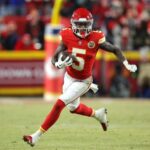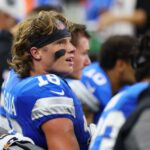By Ross Kelly
In the very first game of the 2025 NFL season, the defending champion Philadelphia Eagles defeated the Dallas Cowboys 24–20. Much of the talk leading up to the game centered on Dallas having just traded away star pass rusher Micah Parsons to the Green Bay Packers after a lengthy standoff in contract negotiations. While Parsons would make his Packers debut three days later with Green Bay, he could have very well taken part in that NFL Kickoff Game, albeit against the team that Jerry Jones owns.
There was a high level of interest from the Eagles to trade for Parsons, and there was even an official trade offer sent from Philadelphia to Dallas. On Sunday, NFL insiders reported that the offer was two first-round picks, a third rounder, and a fifth rounder. The Cowboys, obviously, declined Philadelphia’s offer and instead dealt Parsons out of the division for two first-round picks and DT Kenny Clark.
Jones confirmed the Eagles offer on Tuesday in a radio interview with 105.3 The Fan in Dallas. He also revealed details about his team’s response to Philadelphia’s offer, and why the Cowboys turned down the Eagles’ trade proposal.
“There was no counteroffer,” Jones said of the Eagles proposal. “The thought all along was to see where the interest level was, and that was very important. From the get-go, there was an effort on our part to chum up interest, and that’s a part of what was going on during those months that we were talking about Micah. As it would happen, and as it always happens, once that interest started really peaking, then you started having that phone ring, and that’s exactly what happened.”
So, Jones appears to be saying that he used the Eagles as a bargaining chip to drum up more interest around the league and to get better offers from other teams. It’s a matter of opinion on if the Packers’ or Eagles’ offer was better, but Jones then followed up with another quote that seemed to contradict what he had just said.
“He’s a great player, but if the principle specifically is, with our system the way we have it today, if we can get four, five, six players for one player, that’s better for our opportunity to win the thing,” Jones said. “That’s what it was about. It didn’t surprise me. We had others call. The closer we got to the time we traded Micah, the more the phone started ringing, and that’s what we wanted.”
Jones implied that the more players they could get for Parsons, then the better off Dallas would be with a potential trade. By that logic, the offer from the Eagles was better as it included four draft picks—so, four potential players—whereas Green Bay’s accepted offer was two draft picks and one active player.
Then there’s the fact that the reason Parsons ended up getting traded in the first place was due to money. Dallas didn’t want to fully commit to him because of the financial strain the large contract he desired would put on the Cowboys as a whole. The Packers eventually did acquiesce to Parsons’s contract desires, but one could only assume that if the Eagles were the ones who traded for Parsons, they would also give him a similar long-term contract that Green Bay did.
Thus, the financial strain that Jones was talking about with his team would then be upon the Eagles franchise—a divisional rival—which would weaken their long-term prospects, if you go by Jones’s logic during this ordeal. You would think he’d rather weaken a team who he sees twice a year, rather than the Packers, who have played Dallas just twice in the regular season over the last seven years.
Regardless, Parsons is in a different shade of green than the Kelly Green that the Eagles are synonymous with. He made an instant impact with his new team, recording a sack in Green Bay’s Week 1 win over the Detroit Lions, despite playing in a career-low of 30 snaps.
Clark, who the Cowboys deem as more valuable than third and fifth-round picks, also made an impact in his Dallas debut. He had five tackles in the Week 1 loss to the Eagles, which is more than he had in all but one game last season. He was described as a run stopper by Jones upon his acquisition, and while he was part of a unit that limited Saquon Barkley to 60 yards on the ground, Philadelphia, as a team, rushed for 158 yards and three touchdowns.
Last year the Cowboys allowed an average of 137 rushing yards per game, which was the fourth-most in the NFL. The draft capital Dallas acquired is the main part of the trade, but Cowboys fans may be longing for the offer that Philly proposed if Clark doesn’t help shore up the team’s run defense.
We won’t have to wait too long for the main figures in this whole situation to meet as Parsons and the Packers will visit the Cowboys in Week 4 on Sunday Night Football.





